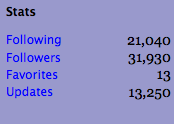Twitter is starting to limit how many other Twitterers any one person can follow. While the number varies based on different factors, for most people (other than Robert Scoble)
 the ceiling seems to be 2,000. This has caused some consternation among bloggers
the ceiling seems to be 2,000. This has caused some consternation among bloggers (blogsternation?). You'd think Twitter was limiting free speech. But it's not. It's trying to limit spam
(blogsternation?). You'd think Twitter was limiting free speech. But it's not. It's trying to limit spam and perhaps this will help with its scaling issues as well.
and perhaps this will help with its scaling issues as well.  There is still no limit on how many people can follow you. And some people (like Scoble, who follows 21,000 people), may be grandfathered in. For normal humans, though, there is really no need to follow more than a few hundred people. (Although, a fake follow would be nice just so people don't feel bad when you don't reciprocate their follows).
There is still no limit on how many people can follow you. And some people (like Scoble, who follows 21,000 people), may be grandfathered in. For normal humans, though, there is really no need to follow more than a few hundred people. (Although, a fake follow would be nice just so people don't feel bad when you don't reciprocate their follows).
But the power of Twitter is more about how many people are following you than how many you are following. It is about pulling together an audience and talking to them directly, and letting them reply directly in a way that seems intimate but is still quasi-public.
The limit on how many people you can follow actually reinforces this dynamic. When you send out a Tweet, it is a one-to-many communication. When you follow other people's tweets, that becomes a many-to-one river that quickly becomes hard to manage.
Some people are suggesting that Twitter might start charging a premium subscription for people who want to follow more than 2000 others. But I'm not sure there's much of a business there. Hard-core Twitterers might be more willing to pay for guaranteed up time or other extra features. If Twitter is going to charge heavy users extra, it would make more sense to charge people who have a gazillion followers because they have more to lose if they can't use Twitter: their audience. Except that would only work if there were no other alternatives they could migrate to, such as FriendFeed or Identi.ca .
or other extra features. If Twitter is going to charge heavy users extra, it would make more sense to charge people who have a gazillion followers because they have more to lose if they can't use Twitter: their audience. Except that would only work if there were no other alternatives they could migrate to, such as FriendFeed or Identi.ca .
And if you ask Twitter co-founder Evan Williams what his business model will be, as we did, he'll tell you he is thinking more along the lines of charging commercial users of the service than power users.And that's probably a good idea, because alienating the power users is a sure way to drive them to other services, and their audiences with them.
| Website: | twitter.com |
| Location: | San Francisco, California, United States |
| Founded: | March 1, 2006 |
| Funding: | $20.4M |
Launched in July 2006, Twitter is social networking and micro-blogging site that allows users to post their latest updates. An update is limited by 140 characters and can be posted through… Learn More
This post was originally posted by our content partner Techcrunch and has been republished with permission.




No comments:
Post a Comment